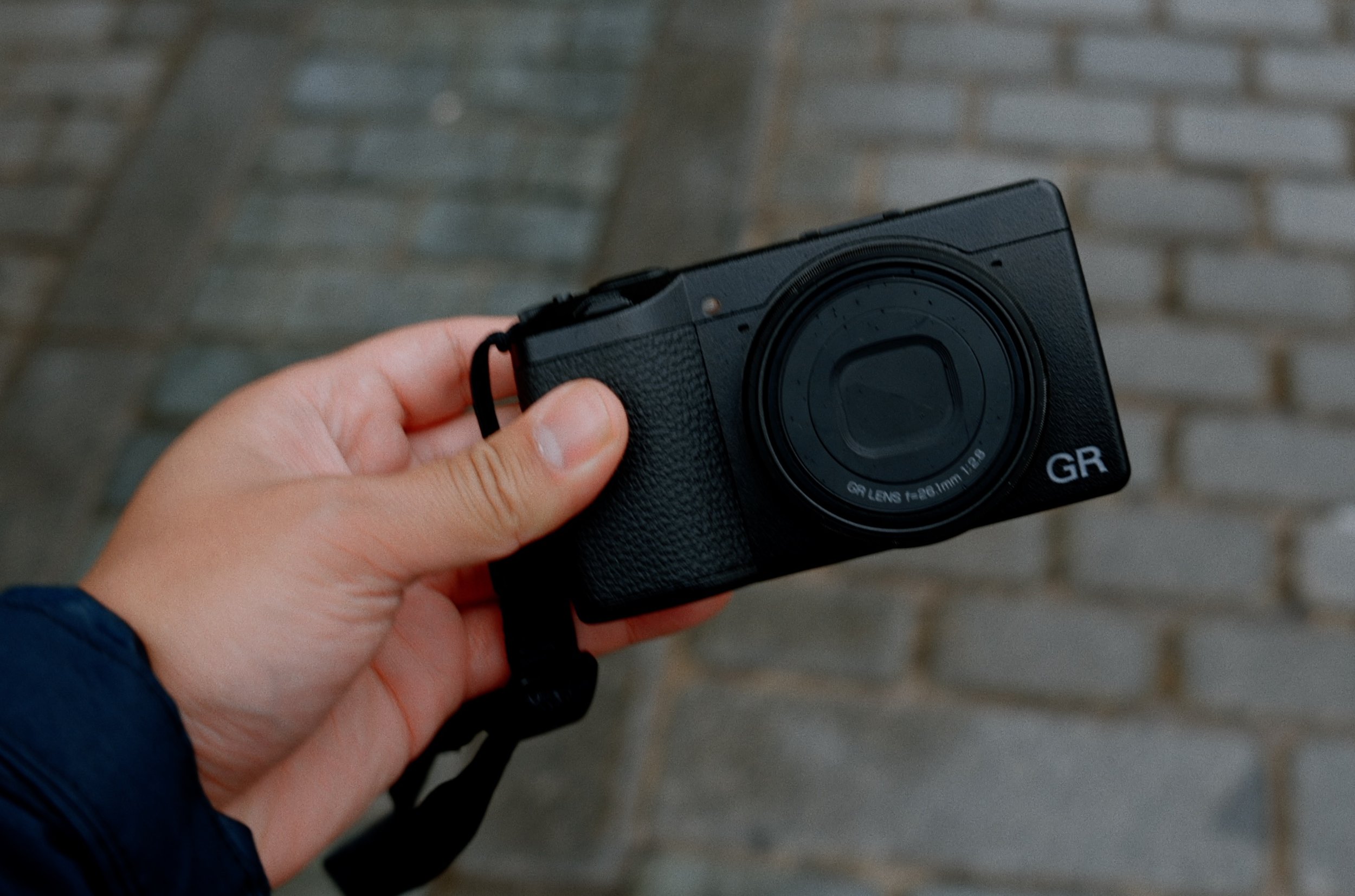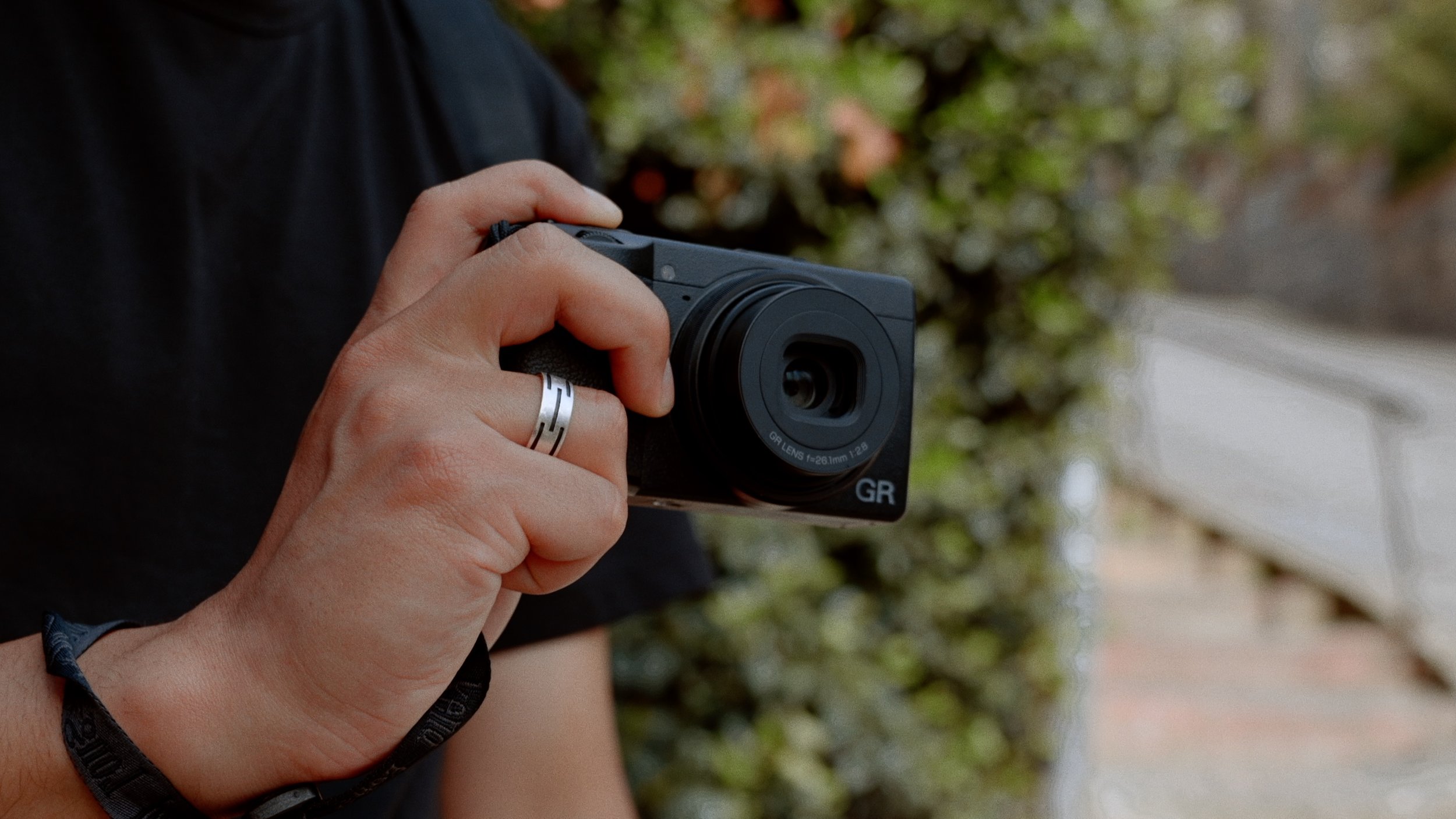Ricoh GR iiix First Impressions
The Ricoh GR iiix is an inconspicuous pocket size 24 megapixel camera hosting a fixed 40mm lens that is easy to carry with you wherever you go. It’s all black body and subdued graphics make the camera almost disappear when you carry it.
Ricoh GR cameras are highly regarded amongst the street photography community as one of the best pocket sized cameras available.
Most of you who watch my YouTube channel know that I’m primarily a Fujifilm shooter. The X100V and the X-E4 cameras are my go to for street photography and that’s not changing anytime soon, but I wanted to see what the hype was about and offer my first impressions on this new version of the GRiii.
Ricoh didn’t send me this camera, they didn’t sponsor my video or this article so these are my honest, and hopefully unbiased first impressions of this little guy. This isn’t a formal review of the camera, but hopefully some of the things I cover can help anyone thinking of purchasing one of these cameras.
Portability
The main selling point of the GR series is their size. They fit right in this niche market of fixed lens pocket sized cameras. Cameras with the specific purpose of being small enough to go in your pocket and be carried everywhere you go.
A lot of people instinctively might want to compare this camera to the X100V, and it will be hard for me to not make those comparisons as well, because that's the camera I am most familiar with. I want to be clear that I personally don’t think it’s a fair comparison as their designs are quite different.
The Ricoh GRiiix is designed to be a small pocket camera and it’s why it lacks a viewfinder and is about half the size of the X100V.
The X100V is not designed to be a pocket camera. It’s designed to feel like your traditional film camera.That said, they are both designed to be small, compact, fixed lens cameras, so I understand where the comparison comes from, but it’s not an apple to apple comparison.
A better comparison is the Fuji XF10 as it doesn’t have a viewfinder as well and is meant to fit in your pocket. I don’t have any personal experience with that camera but I know Sergio Villasano has a great video on his YouTube channel on that camera.
On the topic of actually being able to pocket a camera, it was something I did not expect to be so freeing as it was. It allowed me to easily carry a camera wherever I went. There’s just something about slipping a quality camera into your pocket that takes portability to a whole new level.
I have talked about the iPhone and using it for street photography in a previous video on my YouTube channel and for a lot of people that ends up being the “camera” they use most of the time for those daily life moments as it’s just so convenient because it’s always on us. However, there are times where you want a more professional camera than a smartphone and with a camera at this size, it makes it almost as easy to bring it with you wherever you go.
And for street photographers that’s incredibly valuable because a lot of the best moments happen when we don’t expect it. It is so compact that one does not need a neck strap or a camera bag to carry this camera with you, just a pair of pants with a pocket to slip it away in.
I think one of the best ways to improve your photography is simply by bringing the camera with you everywhere you go. It gets you to actually take photos and think about photography rather than solely rely on a smartphone which tends to become an afterthought. A small portable camera can help you make photography part of your lifestyle and a dedicated camera that you carry with you reminds you that you are a photographer.
Is Pocket Size Better?
People say the Ricoh GR is meant to be a one hand operated camera.
In most cases it does work with one hand, but really only when you don’t need to access these other function buttons and shoot in p mode. That’s what I mostly did with this camera and it did a decent job with auto exposure.
I sometimes felt that the camera was a little too small. There were moments when I tried to use the other function buttons with my thumb and I could feel my fingers slipping across the front grip. If I didn’t have a hand strap on the camera I’d feel like I was pretty close to dropping it. So here and there my left hand did come to the rescue and help stabilize the camera from losing control of it. I think I’m just so used to the size of the x100v, that it feels better in the hands.
But the Ricoh has to be small because that’s the whole point of it. But the smaller you make the camera at a certain point you start to lose ergonomics and with that a loss of control. And I think this is one of those instances, but again it might be me needing to get use to the small size.
40mm Lens
The 40mm lens on the GRiiix is the only real difference between it’s GRiii counterpart which sports a 28mm lens.
Depending on who you are and how you shoot a 40mm might be the better option for you for street photography.
It’s widely considered that 28mm or 35mm are the best focal lengths for street photography, but that’s just people’s opinions, it doesn’t mean that’s going to be the case for you. If you’re someone that likes the run and gun approach, and isn’t shy about getting close to subjects on the street, the 28mm might suit you better.
But if you like to move slower, maybe focus on finer details in a scene, the 40mm might be better.
Personally I love the 35mm focal length. I think it’s the most versatile focal length out there, but occasionally I find it being just a little too wide sometimes. The 40mm adds just a little bit more length, and sometimes that’s just enough for situations where I’m a little too far from a subject.
That being said, I think anyone who uses 35mm will feel closer to home with a 40mm lens versus a 28mm lens.
Now how does a 40mm lens fit for a camera that’s meant to be taken wherever you go? Does it really fit that type of shooting?
I think you’re inevitably going to find instances where it doesn’t work well because there’s obviously no focal length that works well in every scenario. I think the times you will wish you had a 28mm are going to be less often than the times you wish you had the 40mm. There may be situations where you’re in a confined space and it’s hard to move back to get everything you want in the photo, but for most situations the 40mm captures what you want.
For street photography, it really comes down to your personal preference and approach.
Battery Life
This camera does not have great battery life. I got about 200 shots or so on a fully charged battery. When a battery is this small, I don’t think you can expect a full day of shooting on one battery.
I really have no issues with the battery because I always carry more than one with me. I do it with every camera I’ve ever owned. But It’s noteworthy to mention for anyone considering this camera, I don’t think you can get away with owning just one battery. You’re going to need at least one more. Maybe even two.
I found two extra batteries to be enough for half a day of extensive shooting, but also turning the camera off and on.
The camera turns on very fast so I didn’t really feel like I was at a disadvantage if it was off. I could turn it on as I raise the camera up and by the time it was up like this it’d be on.
If you plan on shooting with this camera from morning to sunset, Without going back to home base, I’d recommend bringing a portable charger. Or at least three to four batteries.
LCD Screen
Personally I don’t mind not having the viewfinder on a camera like this because I understand that defeats the purpose of the GR, but I do wish there was a tilt screen on a camera that only has an LCD screen.
I used the tilt screen on my X100V and X-E4 all the time. It lets me have an easier time composing because I can hold the camera at certain angles and still clearly see the screen without breaking my 60 year old back.
The Fuji X70 is a pocket size camera that has a tilt screen so it’s not like it’s not possible to make a small camera and have a tilt screen.
Maybe with a 28mm lens getting a perfect composition in camera is not much of a big deal as there is more leeway in editing, but with a 40mm lens, I feel it is important to get it correct in the shot.
In bright sunny environments it was also a little difficult to see the fine details of what I was shooting. A tilt screen would help in those situations, and definitely help me compose better with the 40mm.
Snap Focus
One of the unique features of the GR cameras is snap focus. Basically a version of zone focusing on the GR.
You can set the zone at which you want your focus range to always be, and when you pair regular auto focus with full press snap it lets you have full range autofocus as you would normally do and whatever your snap focus range is.
So basically two types of focus at your fingertip. It’s a really cool feature that is not as gimmicky as you might think. However I think this feature works a lot better for a wider lens like on the original GRiii’s 28mm.
So far I haven’t really found the need to use snap focus on the GRiix, but I’ve kept the snap focus feature on for 2m, so if I do happen to see something quickly unfolding in that range, I don’t have to think twice about autofocus, just simply full press the shutter and I know it will get it in focus as long as it’s at that distance.
Pretty cool to have that in your back pocket.
Image Quality
The 24 megapixel Image quality I think speaks for itself. This lens is incredibly sharp and capable as you can see from the attached photos. For additional photos and in the field use check out my YouTube videos and photos on Instagram of my trip to Istanbul where I shoot with the GRiiix.
Final Thoughts
This is a niche camera and sits at a fairly expensive price point for what it is, but depending on how you look at it, the convenience of having a capable camera that isn’t your phone, attached to your hip, in my opinion is worth the money. It can be the difference between taking photos or not taking them.





